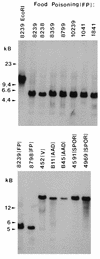Evidence that the enterotoxin gene can be episomal in Clostridium perfringens isolates associated with non-food-borne human gastrointestinal diseases
- PMID: 9431915
- PMCID: PMC124802
- DOI: 10.1128/JCM.36.1.30-36.1998
Evidence that the enterotoxin gene can be episomal in Clostridium perfringens isolates associated with non-food-borne human gastrointestinal diseases
Abstract
Clostridium perfringens enterotoxin (CPE) is responsible for the diarrheal and cramping symptoms of human C. perfringens type A food poisoning. CPE-producing C. perfringens isolates have also recently been associated with several non-food-borne human gastrointestinal (GI) illnesses, including antibiotic-associated diarrhea and sporadic diarrhea. The current study has used restriction fragment length polymorphism (RFLP) and pulsed-field gel electrophoresis (PFGE) analyses to compare the genotypes of 43 cpe-positive C. perfringens isolates obtained from diverse sources. All North American and European food-poisoning isolates examined in this study were found to carry a chromosomal cpe, while all non-food-borne human GI disease isolates characterized in this study were determined to carry their cpe on an episome. Collectively, these results provide the first evidence that distinct subpopulations of cpe-positive C. perfringens isolates may be responsible for C. perfringens type A food poisoning versus CPE-associated non-food-borne human GI diseases. If these putative associations are confirmed in additional surveys, cpe RFLP and PFGE genotyping assays may facilitate the differential diagnosis of food-borne versus non-food-borne CPE-associated human GI illnesses and may also be useful epidemiologic tools for identifying reservoirs or transmission mechanisms for the subpopulations of cpe-positive isolates specifically responsible for CPE-associated food-borne versus non-food-borne human GI diseases.
Figures


References
-
- Bean N H, Goulding J S, Lao C, Angulo F J. Surveillance for foodborne-disease outbreaks—United States, 1988–1982. Morbid Mortal Weekly Rep. 1996;45:1–54. - PubMed
-
- Boehringer Mannheim Biochemicals. The Genius system users guide for filter hybridization. Indianapolis, Ind: Boehringer Mannheim Biochemicals; 1992.
-
- Borriello S P. Newly described clostridial diseases of the gastrointestinal tract: Clostridium perfringens enterotoxin-associated diarrhea and neutropenic enterocolitis due to Clostridium septicum. In: Borriello S P, editor. Clostridia in gastrointestinal disease. Boca Raton, Fla: CRC Press, Inc.; 1985. pp. 223–228.
Publication types
MeSH terms
Substances
Grants and funding
LinkOut - more resources
Full Text Sources
Molecular Biology Databases
Research Materials
Miscellaneous

